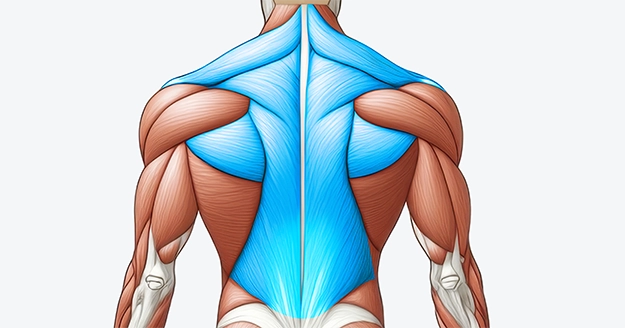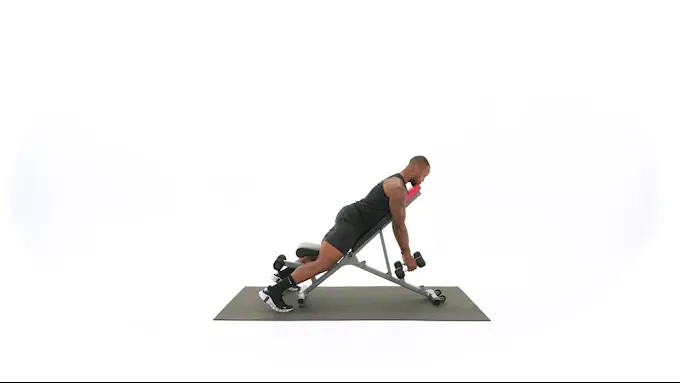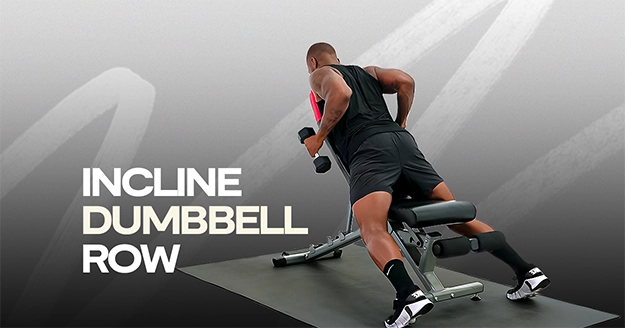Exercise Profile
Incline Dumbbell Row Overview
The Incline Dumbbell Row is a key upper-body exercise that emphasizes building the latissimus dorsi, trapezius, and rhomboids, while also working the biceps and rear deltoids. It’s a versatile movement that fits well into different workout routines, helping to build muscle mass and strength, and enhance posture.
The Incline Dumbbell Row is a great exercise that beginners may do to strengthen their upper and mid back. More advanced athletes can incorporate variations like the single-arm row or increase the weight to enhance difficulty and target the back muscles more intensively.
The Dumbbell Incline Row can be incorporated into your workout routine in various ways. It can be used in pull-focused training to improve posture and upper-body endurance or incorporated into a specific back or upper-body workout. It can also be included in full-body workouts to promote overall muscle balance.

Incline Dumbbell Row Instructions
Step 1: Set up the bench to a 45-degree incline. Then, grasp a pair of dumbbells. Lie facedown on the bench and plant the balls of your feet on the floor.
Step 2: Pull the dumbbells toward your torso, exhaling as you row. Bring your shoulder blades close together and pause for a moment. Remember to keep your back neutral.
Step 3: Then, stretch your arms toward the floor to lower the weights, inhaling as you do so.

Common Incline Dumbbell Row Variations
The Dumbbell Row is a staple exercise, but you can mix things up with different variations to adjust the difficulty or target specific muscles more effectively. Here are five popular variations to consider adding to your routine:
Incline Dumbbell Row Tips
- Throughout the exercise, maintain a flat back and keep your chest out to avoid strain and guarantee optimal muscle activation.
- Pick a weight that enables you to perform the exercise steadily and in good form. Focus on a smooth, steady motion rather than lifting too quickly.
- Tighten your core to help stabilize your body and support proper posture during the row.
- Try varying the inclination angle until you reach a comfortable and effective position for your back muscles.
- Breathe steadily to assist your performance: exhale as you bring the weights towards you, and inhale as you lower them.
Incline Dumbbell Row Common Mistakes
- Rounding the Back: To avoid strain, maintain a straight back and an elevated chest.
- Using Momentum: To improve muscle engagement, concentrate on controlled movements rather than swaying the weights.
- Not Fully Extending: Extend your arms at the bottom to maximize effectiveness.
Frequently Asked Questions
Which is more effective, the incline or flat dumbbell row?
Both incline and flat dumbbell rows are effective but target different areas. Whereas flat rows emphasize the lats and mid-back, inclined rows highlight the upper back and traps. For balanced back development, using both in your routine is ideal.
What should the bench incline dumbbell row angle?
To appropriately work the upper back muscles while avoiding tension on the lower back, put the bench at a 30-45-degree angle.
Does better posture come from using an incline row dumbbell?
Yes, incline dumbbell rows strengthen the upper back muscles, which can help improve posture by counteracting rounded shoulders.
Do dumbbell rows help increase arm size?
Dumbbell rows work the biceps and forearms to enhance arm size, but their main effect is on the back.
How can I make the dumbbell incline row more challenging?
Increase the weight, slow down the tempo, or add a pause at the peak of the movement to increase the challenge and muscle engagement.
Post your post-workout selfies in IG and tag @trainestapp, #trainest, or DM them to us to get a shoutout on Trainest Stories!


